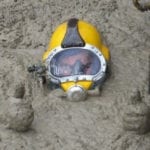 Technology
Technology  Technology
Technology  Humans
Humans 10 Everyday Human Behaviors That Are Actually Survival Instincts
 Animals
Animals 10 Animals That Humiliated and Harmed Historical Leaders
 History
History 10 Most Influential Protests in Modern History
 Creepy
Creepy 10 More Representations of Death from Myth, Legend, and Folktale
 Technology
Technology 10 Scientific Breakthroughs of 2025 That’ll Change Everything
 Our World
Our World 10 Ways Icelandic Culture Makes Other Countries Look Boring
 Misconceptions
Misconceptions 10 Common Misconceptions About the Victorian Era
 Mysteries
Mysteries 10 Strange Unexplained Mysteries of 2025
 Miscellaneous
Miscellaneous 10 of History’s Most Bell-Ringing Finishing Moves
 Technology
Technology Top 10 Everyday Tech Buzzwords That Hide a Darker Past
 Humans
Humans 10 Everyday Human Behaviors That Are Actually Survival Instincts
 Animals
Animals 10 Animals That Humiliated and Harmed Historical Leaders
Who's Behind Listverse?

Jamie Frater
Head Editor
Jamie founded Listverse due to an insatiable desire to share fascinating, obscure, and bizarre facts. He has been a guest speaker on numerous national radio and television stations and is a five time published author.
More About Us History
History 10 Most Influential Protests in Modern History
 Creepy
Creepy 10 More Representations of Death from Myth, Legend, and Folktale
 Technology
Technology 10 Scientific Breakthroughs of 2025 That’ll Change Everything
 Our World
Our World 10 Ways Icelandic Culture Makes Other Countries Look Boring
 Misconceptions
Misconceptions 10 Common Misconceptions About the Victorian Era
 Mysteries
Mysteries 10 Strange Unexplained Mysteries of 2025
 Miscellaneous
Miscellaneous 10 of History’s Most Bell-Ringing Finishing Moves
Top 10 Weirdest Jobs in Science Fiction
Cities evolve. People evolve. Even the planet evolves. And so does the way we earn our money. The Golden Age of Science Fiction imagined a brighter future in which the problems of the past are solved by better technology and more enlightened ways of thinking. However, its optimism has since been crushed by the advent of nuclear weapons, the scarcity of natural resources, and the panoptical vision of state surveillance.
The writers of the new wave era imagined darker futures in which our problems have evolved in bizarre and unsettling ways. Philip K. Dick opined, “There will come a time when it isn’t ‘They’re spying on me through my phone’ anymore. Eventually, it will be, ‘My phone is spying on me.’” In this list, we will look at 10 of the strangest jobs in science fiction, some of which may actually come to be.
Related: Top 10 Fascinating Facts About Books
10 Spacer
Aye, and Gommorah by Samuel R. Delaney has been called the greatest story by a gay man in the 1960s and is the finale of the Dangerous Visions anthology, a book of unsettling predictions. It follows a spacer, who has essentially been made agender through an advanced form of surgery in order to avoid the effects of space radiation on their gametes. A subculture has arisen on Earth of people called Frelks who fetishize these types of people.
Despite being asexual, the protagonist works as a prostitute, partly for the money and partly for the human connection. Conflict arises when a woman wants to sleep with them but doesn’t want to pay. She is sexually attracted to Spacers, and seeing as they’re mostly prostitutes on Earth, she is unable to form an emotional attachment to one. The protagonist finds that they are unable to have a sexual relationship with someone without payment, however small, which brings them to loggerheads. A deeply moving story about the evolution of sex work, Aye, and Gomorrah remains one of the most prescient speculations of all time.[1]
9 Layout Co-Ordinator
Philip K. Dick wrote extensively about the future of drugs. A Scanner Darkly follows an undercover agent investigating a drug called Death, and in Faith of our Fathers, the protagonist takes one which helps him see the reality of an alien invasion. The Three Stigmata of Palmer Eldritch is probably his trippiest work of fiction. Its titular character is an intergalactic drug dealer, but its protagonist works for a company that creates “layouts.” These physical props work in tandem with futuristic drugs to help colonists escape the grim reality of life on barren planets and moons.
The strangest thing about these props is that they revolve around a character called Perky Pat, who’s designed to cheer them up. However, sharing the same simulated reality leads to the growth of pseudo-religious cults. Dick often used simulated realities to explore religion but wasn’t entirely critical of faith. Perky Pat is his tacky parody of Christ and represents his predicted decline in actual forms of spirituality.[2]
8 Mechador
Auto-da-Fé by Roger Zelazny is the story of a mechador—which is like a matador. But rather than bulls, they fight charging cars with robotic brains. Though it appears to revolve around a pun, Zelazny’s story has more serious implications for the future of humanity. In Auto-da-Fé, technology has made it possible to revive people from death. This results in entertainment taking bizarre directions.
The protagonist has been crushed several times before a bloodthirsty crowd, similarly desensitized to brutality. He also thinks of his own death as no more than an inconvenience and, because of his job, is trapped in an endless cycle of death and rebirth. Zelazny was interested in reincarnation and Eastern religions, exploring them in novels like the Lord of Light, and Auto-da-Fé is his grotesque inversion of them.[3]
7 Alien Translator
Hundreds of untranslated languages remain, ranging from Linear A, a writing system used by the ancient Minoans, to Proto-Elamite, middle-eastern symbols dated around 5,000 years ago. Archeologists and linguists still struggle to make sense of them, so imagine how hard it would be to understand a language from another world. This is the challenge faced by Dr. Louise Banks in Story of Your Life by Ted Chiang when seven-limbed beings called Heptapods enter Earth’s orbit.
They establish strange mirrors, referred to as looking glasses, which they use to communicate with humans. Dr. Banks discovers that their sentences have no set word order and is even more confused when she finds their writing and speech to be unrelated. Having divided the two forms of their language into Heptapod A and Heptapod B, she begins the even stranger task of understanding how their vernacular reflects how they see the universe.[4]
6 Navigators
Frank Herbert’s Dune distinguished itself from almost all other science fiction that came before by imagining a galactic civilization that was actually less reliant on computers. The story takes place on Arrakis, the most important planet in the universe for being the source of Melange, a drug that facilitates interstellar travel. By bestowing the user with prescience, a form of precognition, it allows navigators to find their way between star systems.
What makes their job even more bizarre is the Holtzman effect. This is a phenomenon in the Dune Universe which allows spaceships to travel faster than light. Herbert may have been vague about its details, but he refers to concepts like folded space. Navigators must therefore grapple with inconceivable dimensions and, in the process, become addicted to the spice, Melange.[5]
5 Child Trader
The Female Man by Joanna Russ was one of the seminal works of feminist science fiction of the 1970s and follows four women, each of whom comes from a separate parallel universe. Joanna lives in one like Earth, Jeannine lives in an unending depression where the feminist movement never entered its second wave, Janet lives in a world where men were exterminated, and Jael lives in the strangest of them all. It is divided between Womanland and Manland as the sexes have split into factions and are constantly at war with each other.
However, they still rely on trade, and in exchange for resources, the Womanlanders offer their male offspring while keeping the female ones. The job of the child trader is to sell boys at the best price. What makes this particularly disturbing is that in lieu of female companionship, the men of Manland operate on their young to create substitutes for women.[6]
4 Observer
Boris and Arkady Strugatsky were the two most important writers of Soviet Russia, and together, they authored Hard to be a God, a novel about going undercover on an alien world that never progressed past the Middle Ages. The protagonist travels with other observers under the alias Don Rumata and is able to blend with the aliens as they resemble humans and employ recognizable feudal structures.
This is a particularly strange job as, despite having come from an advanced and utopian Earth, he must resist the urge to intervene. It becomes too much for him when the educated get blamed for all the troubles in the kingdom. A campaign is launched against them—a shift toward totalitarianism—which he perceives as exceeding those in equivalent medieval societies. A debate then ensues over whether it’s right to get involved with the development of another civilization and whether meddling would distort their own perspective of a world they visited to better understand their own history.[7]
3 Ancillary
Ancillaries in Ann Leckie’s Ancillary Justice are human bodies that are used as soldiers by an AI who also controls a spaceship. The main character is Breq, the only surviving ancillary of a ship called The Justice of Toren. It belonged to the Radch empire, a civilization that does not distinguish between gender (everyone going by she pronouns). So, in addition to being part of a fragmented consciousness, Breq must contend with being unable to distinguish between sexes. (Leckie refers to everyone by she in order to help the reader share in her confusion.)
The plot is made even more complicated by flashbacks to when Breq was part of a larger consciousness, interspersed with her quest to avenge the destruction of her ship. The job of an ancillary is particularly strange when you consider that, unlike a regular soldier, they are incomplete without a purpose bonding them to a higher consciousness. Breq is so embittered by the loss of this link that she is driven to exact revenge against an entire empire.[8]
2 Illyrion Miner
In Samuel R. Delany’s Nova, illyrion is the most valuable substance in the universe. It is a superheavy element, a few grams being more than enough to power a spaceship. The heart of a dying star is its most abundant source, and it is up to a band of misfit cyborgs to fly through the heart of one going nova. Despite the potential to kill them or destroy their minds, they are driven to resolve an economic war between the two most powerful families in the galaxy.
Much like Jason going after the golden fleece and the Knights of the Round Table seeking the Holy Grail, Nova’s heroes are guided by magic. They rely on tarot cards to predict stakes as well as the outcome of their missions. The capacity of their ship to withstand the heat of a nova also implies that the story happens in a world that assumes the loose physics of myths from antiquity.[9]
1 Void Ship Pilot
Norman Spinrad wrote some of the strangest books in the history of science fiction, and his strangest is arguably The Void Captain’s Tale. Combining elements of eroticism and horror, it follows the captain of a pleasure vessel on its journey through space. His pilot is Dominique Alia Wu, who powers the ship’s interstellar drive with her own psyche and propels it via orgasm. Space travel, in Spinrad’s novel, takes an erotic form, with the pilot achieving quasi-religious ecstasy while entering jump speed.
If her job wasn’t already strange enough, having sexual control over the ship also has an effect on its crew. Though required to distance herself from other crew members, the captain develops an obsession that makes him lose his status and become wholly subordinate to her will. The experience of traveling at lightspeed using only her libido also gives her delusions of grandeur, and using the captain, she attempts to merge consciousness with Spinrad’s version of God.[10]








